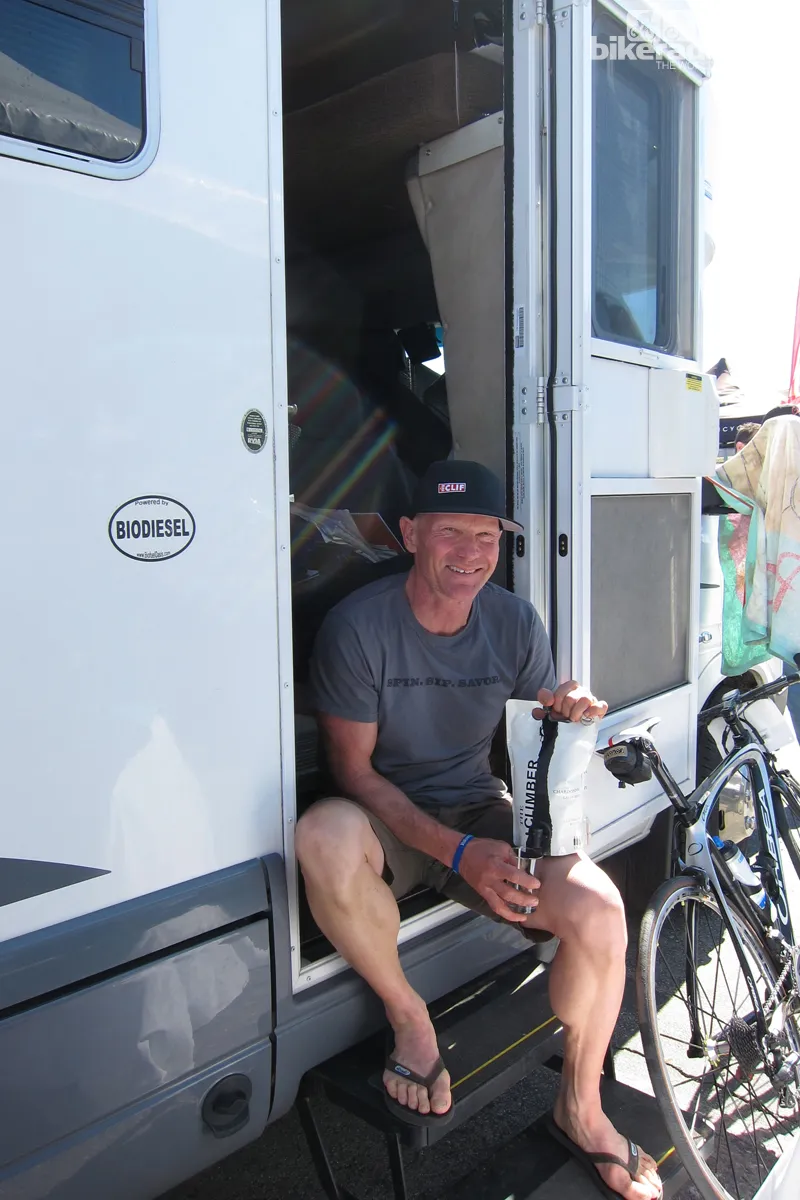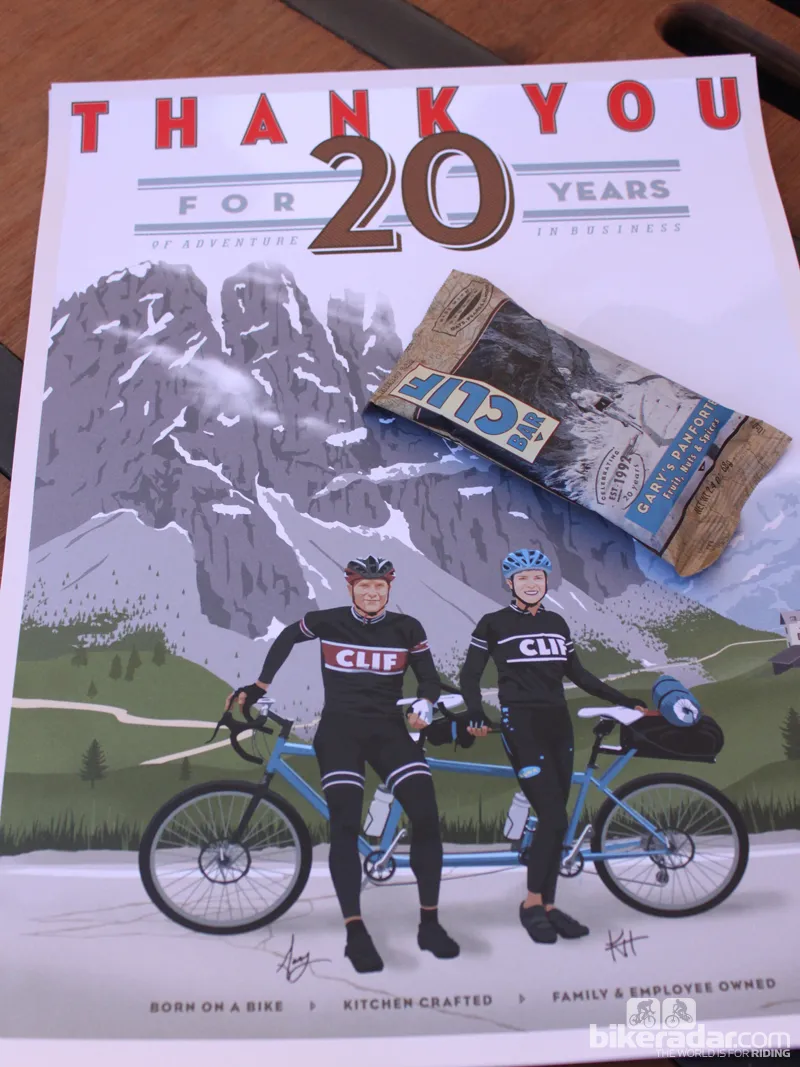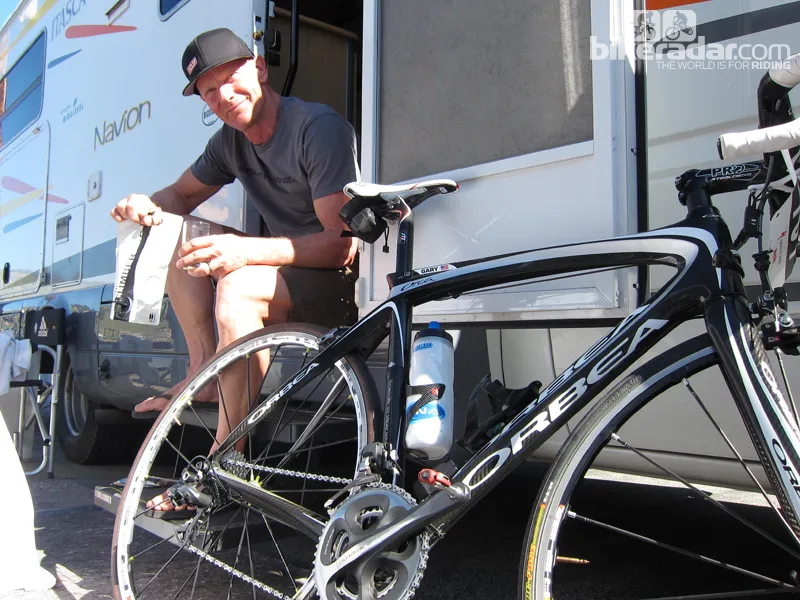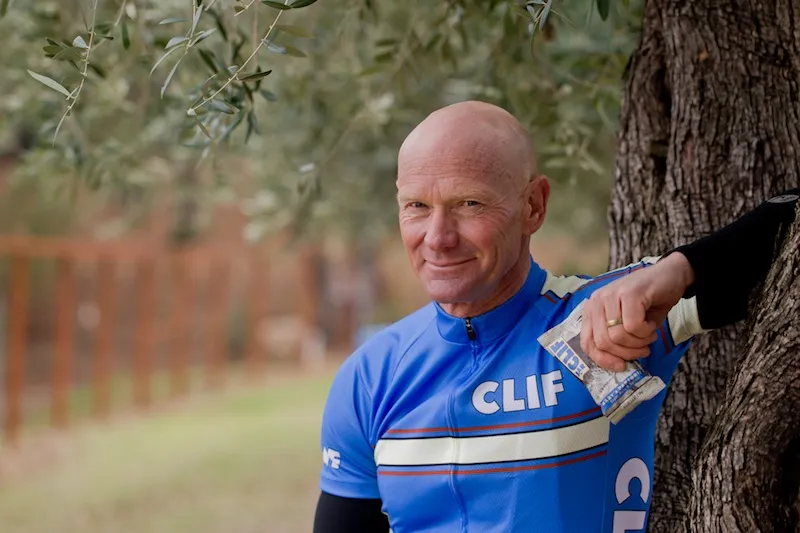Gary Erickson is an admirable man. He remains at the helm of CLIF Bar an energy products company he founded 20 years ago, when he could have retired ten times over.
More than simply keeping things private, in a business sense, he’s cultivated a sense of family within CLIF Bar Company that is different from any corporation, public or private.
He and his wife (who shares the CLIF helm with Erickson) recently opened up 20-percent of CLIF’s shares to their employees in an effort to offer long-time employees the chance at a retirement that’s been long gone for most of American’s society. He believes that a 401k (pension) isn’t enough, and he put his money where his opinion stood. Subsidized day care and paid time to serve the community are a few of the other benefits CLIF offer their employees, and they’re all because of Erickson and his wife, Kit, who is also his business partner.
They’ve followed their gut, whether it be: massive commitments to community service, organics, bike racing, or wine, and it seems that it’s all paying off in spades. Erickson talks about growth frequently, but when pinned, he’s admitted it’s organic, and he doesn’t ever put a number out for his team to hit.
It’s this physical ground that may be the secret to his success. He genuinely seems to appreciate where he is, where he came from, and the people — including all of his employees — that have helped him get there.
Erickson enjoys the simple pleasures too. BikeRadar caught up with him at his camper at this past April’s Sea Otter Classic, where he camped for the entire event — where he also shared a glass of wine from his ‘Climber’s pouch’ each night with his friend camping next door, Robert Wilkins, a rep for Orbea bikes. Simple pleasures.

Erickson camped at Sea Otter this year, as he does every year
This summer he and his 18-year-old daughter will embark on a bike trip in the Italian Dolomites — one of his favorite places to ride — the amazing twist in this story, she asked for the trip. As any parent will attest having a teenager want to hang with you, means you are successful — at life’s most important job.
BikeRadar: So 20 years… CLIF Bar is 20 years old. Is it anything close to what you expected it might be when you started it?
Gary Erickson: It was hard to visualize 20 years when we first started. It’s like when you’re a young kid. You can’t think of what it’s going to be like when you’re 20, or even five. I don’t think we could see that far ahead. But I really do think if you can hang onto it that long that maturity really helps you to continue to remain successful. It helps you figure out how to remain successful and continue to grow, and remain growing.
It’s like a lot of things in life, you get to a maturity level and I see a lot of companies in the food industry that never get to 20 because they sell way before that. They never get to experience that maturity. When you’re in the thick of it, you’re not thinking about 20 years.
That said, this is 20-years and it’s a big marker for us. I’m so happy and proud of what we’ve all done to keep this thing going. I really do feel in the last five years we’ve reached a certain stride in that we’ve become exponentially better. Not just that we’ve been growing, but that all aspects of our business are at this cool, thriving, level.
Whether it’s our community service program, our sustainability program, and the benefits for our employees, our new headquarters — all these things have taken it…. There was a feeling when we were younger — we’re at about 300 employees, now — but when we were around a hundred employees, there were some feelings among them, because of maybe going through some hard times, that why can’t we go back to the way it was when we were 25 employees, or 50 employees; it felt more like a family back then. I feel like we got through that, and now at 300-plus, I think, we’re tighter now and more of a family feeling company than we were at 100 or 150. I can’t explain how we got there, but I didn’t think we could. I could be sitting here saying, ‘wow, 20-years, I’m burnt out.’ But it’s more thrilling now than it was 10 years ago.
What’s fostered that family feel? It seems like the company must be run with a fairly flat management structure.
Yeah, the ownership structure; I think the ownership structure is the starting point. If we were a public company, or a company owned by private equity, there would be another goal in mind — and that is to increase shareholder value or grow it as fast as possible because the equity guys want their money in five years.
We don’t have that pressure. My wife and I are here for the long haul, and now it’s 20-percent owned by the employees. That gives us a freedom to do it our own way. If we want to take a left turn, the venture capitalists or private equity guys might say, ‘you can’t do that. That doesn’t grow the company.’ We don’t have to answer to that.
We do stuff that doesn’t pencil out. We think it does, but it traditionally wouldn’t. The amount of money we’ve invested in organic; the amount of money we’ve invested in our employee’s benefits, the childcare center we subsidize; the community service — donating 7,000 hours of community service on company time [CLIF Bar has offered 40,000 hours of community service on company time since 2001; 7,000 is their budgeted goal for 2012] — that wouldn’t pencil out with a board of directors from a large company. We think it builds morale. We think it’s good for the community. We think we get a lot of benefit from that, but it doesn’t pencil out.
[CLIF Bar does a portion of their community service as a whole company, where all 300-plus employees descend on one project for a day, it’s a monumental task to organize and carry out but Erickson sees value in the camaraderie and team building a day’s labor offers; this year they’re working at a community garden.]
How involved are you and your wife in the day-to-day operation of the business?
We’re very involved in certain ways, and in others we’re not. We are not involved in the operations of the company, ordering and manufacturing, but I’m personally involved with starting manufacturing or starting a new product, and seeing it go online, and making sure it’s running right.
I’m still involved with product development and so is my wife. And every package and product that goes out the door has our signature on it. We get very involved in package design, we’ll see it all the way from start to finish and comment along the way; but we also have a great team of creative people that develop that packaging. We feel like, that and the product itself is the foundation of the company. The whole company doesn’t exist without great product and great packaging. From there it takes a great team to promote it, sell it, talk about it.
We’re also involved in the big decisions: converting the company to being employee owned. In moving our facility, we’re involved in every aspect of the building — there’s probably not a color or a carpet that we didn’t at least say, ‘yeah, we like that.’ And we’re just there every week, every other week for a few days, just around. I think it’s important for the employees to understand the agenda of the principals. And if it’s to grow it to sell it, then they can hop on board or not; but in our case our vision is to keep this company private, past our generation.
What pushed you to give up 20-percent of your company to your employees?
The number one reason we did that was because we were looking for a retirement benefit for our employees. We didn’t have anything — we have 401k — but it wasn’t enough for us. We want our employees… if they’re going to work 30-years for CLIF Bar they can leave with something that can look pretty close to a retirement package. There are other benefits that came along with that too: it’s a good incentive for people. It’s a good recruitment tool. It’s also a good incentive for people to stay at CLIF Bar if they know the longer they stay, the longer that retirement package grows. And they also feel a sense of ownership.
You’ve mentioned growth a few times, there’s this uniquely American drive for perpetual growth, but does a company like yours get to a point where staying a certain size is favorable?
I don’t have a great answer for that because I used to struggle with that. I didn’t want it to grow so fast it would get out of control. So our control, we call it natural demand. We don’t force people to grow to a number. We create great product. We desire to innovate, we hire the right people, and we come up with great plans for the next year and then a number pops out of that, which we think we can hit with all of those things. It’s a natural number that comes out, versus… the board of directors says: ‘you’re going to grow 20-percent next year, now tell me how we’re going to do it and make it happen.’
That doesn’t make sense if you really only have the potential to grow 10-percent. So then the pressure is on, and they’re trying to put a square peg in a round hole.
That said we’ve grown faster than we thought we were going to grow. We keep doing these good things. We keep making these great products and people are responding. We keep growing at a pace that’s, well, wow, hard to believe. So it’s exciting, but I don’t know if that’s the American thing you’re talking about.
Yes, I had in mind what you describe your peers being up against.
My peers are closer to the ‘have to grow.’ If next year someone came back and said, ‘even with all the new things we’re doing and all the new products we’re only going to grow two-percent,’ ok great. We’ll make sure that’s a profitable two percent, so we can pay our bills. If they said we’re going to decrease by 10-percent, I’d be concerned.
I think growth does excite people. I have friends in Italy with businesses, and they still want to grow.
As my wife says, and as our president, Kevin Cleary says, growth allows us to do more stuff. More good stuff; more community service, more organic, we can support the Luna team with more resources and all that stuff.
What’s driving the company in terms of development? Is product development also organic? Where do the ideas come from: Luna, Mojo?
They seem to come from everywhere. For example we have the 20th anniversary Panforte bar. So that came out of this wine, at the CLIF family winery that we have, called Brute Blanc, it’s a Sauvignon Blanc, and it’s got a picture of myself on the Gavia in Italy. It’s one of those destination climbs for people to do. There’s now a tunnel there, and around the left side of the tunnel used to be the road; they’ve closed that off so that it’s not really rideable anymore, but back in the day that’s where it went.
I’ve got this shot that now you really can’t take anymore because the fence is falling down and stuff. So we made a wine with that label on it and it was really cool. We made another [wine] called the Climber Limited Red, which has a friend, Ron Kauk, climbing in Yosemite.
So we were talking about what we do for the 20th anniversary, and I’ve been doing trips in Italy since 1982, and my friends in Florence, when I told them I was going to Sienna, they told me that they have this wonderful thing called Panforte; Panforte sienna or something like that. And I tried it and was, wow. This is 1980s way before CLIF Bar.
So I knew in the back of my mind, that it was probably still there, and as we started to develop [ideas] for a special flavor and I looked at the picture and just went: Panforte. It’s got to be Panforte, with that classic nut and fruit, simplicity, and spice, and cocoa powder, and all that. So we went to the kitchen, several of us, and created several different types of traditional Panforte [it comes originally from an 800-year old recipe]. The next thing you know we have Panforte [CLIF Bars] with that image on the front, and I have to say it’s one of the best bars we’ve ever done.
So that’s an example of where things just come out of nowhere. On the other hand we just came up with an extension off Luna bar called Luna Fiber. American’s don’t eat enough fiber; fiber doesn’t really taste very good, so how are you going to make something good? But women are buying fiber products right now, so that is more opportunistic, yet we wanted to create a great tasting product if we’re going to take advantage of an opportunity. So this [Panforte] is out of my vocation, my love to cook, and that experience and the package; that’s from me being a cyclist and a baker — boom. The other [Luna fiber] we know that there’s this trend, this need, so we’ve created a great fiber bar.
Why wine and the winery?
My wife and I moved up to Napa Valley, we bought our place in the ’90s, and moved up full time in 2003. Our kid was going to a small school there, and no joke, 90-percent of the parents there were into the wine business. So we just became friends with all of these wine makers, vineyard managers and all of these people, and they just floated this idea — why doesn’t CLIF come out with a wine? We said, well first off CLIF bar doesn’t have any vineyards. And they said, ‘you don’t need vineyards to start a wine, just buy grapes. We all buy grapes.’ Most wineries have their vineyards and they buy stuff. We said, ‘really?’ …. So we did 300 cases of Kit’s Killer Cab the first year.
We thought we’d just do it as a little hobby. You know, on the side, sell a few bottles, put some away, and make it a kind of CLIF Bar thing, and it just didn’t turn out that way. It kept growing, and growing, and growing. Next thing, I’m doing Gary’s Improv: a zinfandel, different blends, then we did the Climber a white sauvignon blanc blend, and a red zinfandel blend; we came out with the pouch last year, then we opened up Velo Vino, our tasting room, which celebrates bikes and wine, just a year ago.
So that’s our tasting room, it’s open seven days a week, we run bike trips out of there. You walk in there and it’s like, wow, this is a bike museum. We have old bikes, we have Catharine Pendrel’s Olympic bike, and we have pictures of cycling going back 50 years all over the walls.
It’s all about cycling and wine. We do bike rides out of there, we hold clinics, and it’s a home for CLIF too. Word has gotten out, and on a Saturday afternoon it’s wall-to-wall people. People say it’s the friendliest tasting room in the valley.
Where’s CLIF Bar 20-years from now?
Well, we’ll probably have more employees; we’ll probably have more products. I’m hoping I’ll still be camping here. There will also be the things we always do [community service, organics, providing for the CLIF family].
Always in cycling?
I don’t see us ever getting out of cycling — it’s been so good to us. It’s really why we’re here. We came up with the idea on a bike, and racing bicycles, it’s got to be our core sport.

2012 marks CLIF Bar's 20th anniversary: they're celebrating with a hearty 'thank you' and the new Panforte flavor

